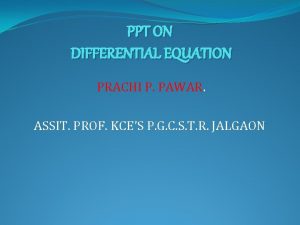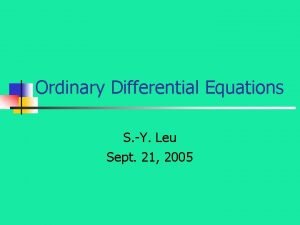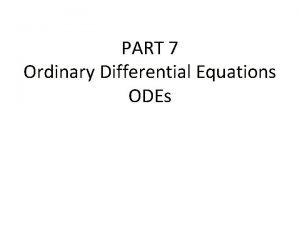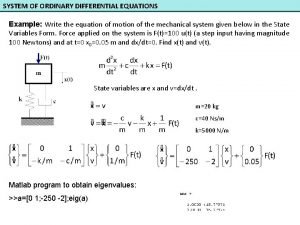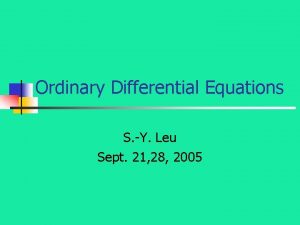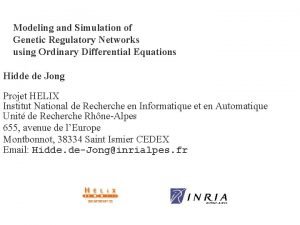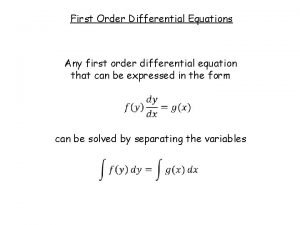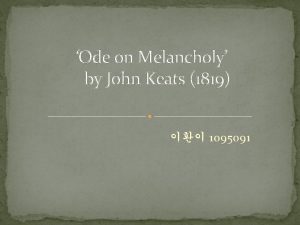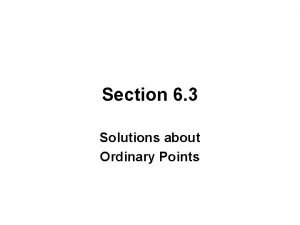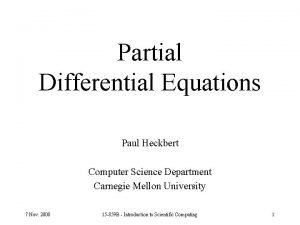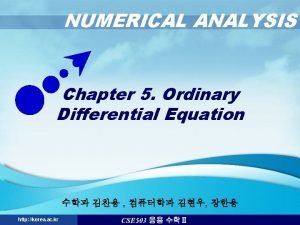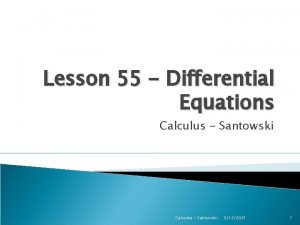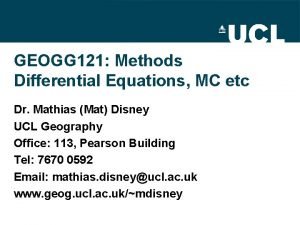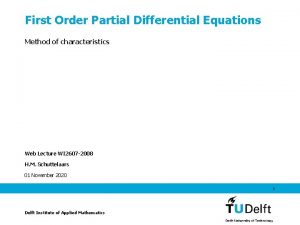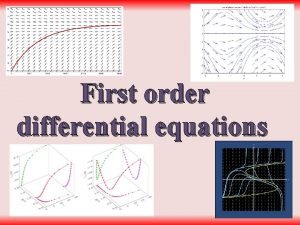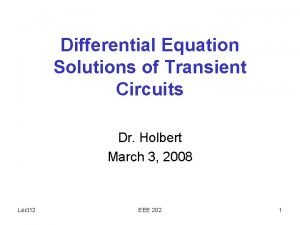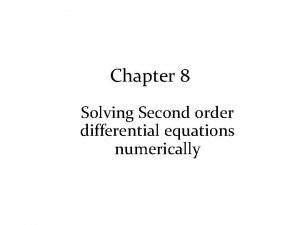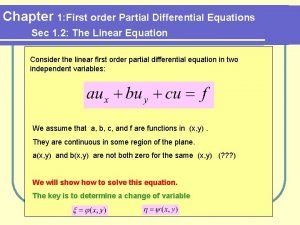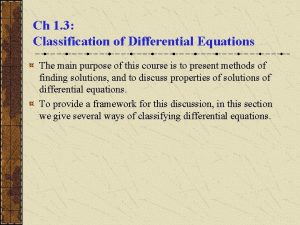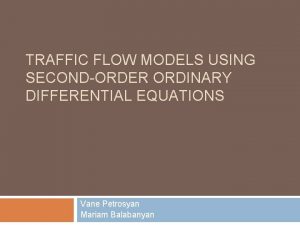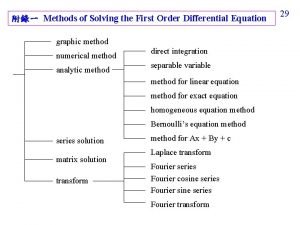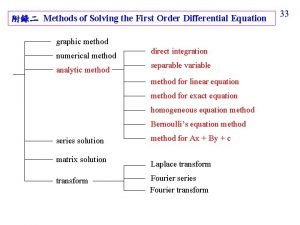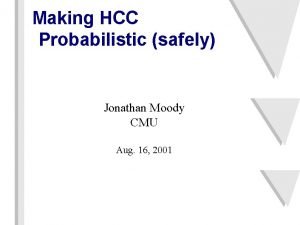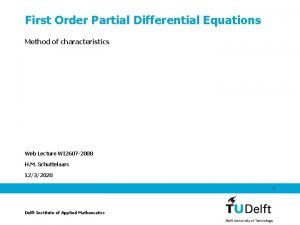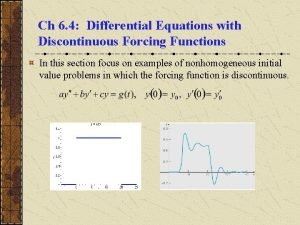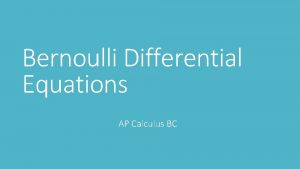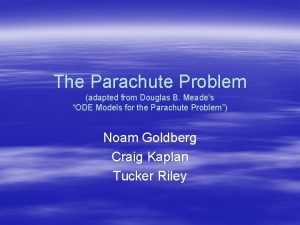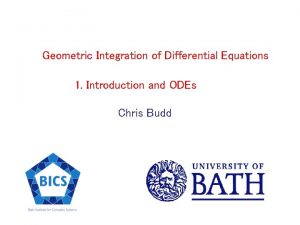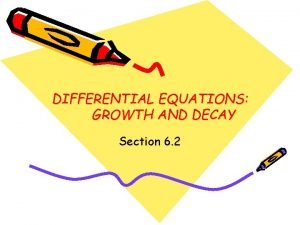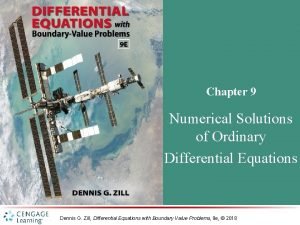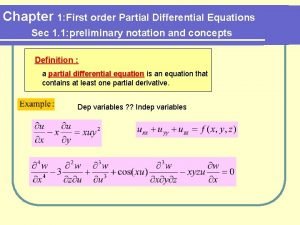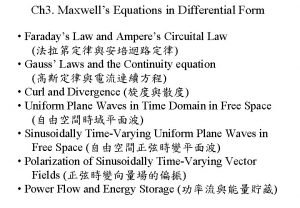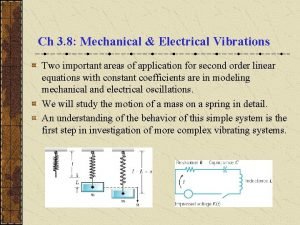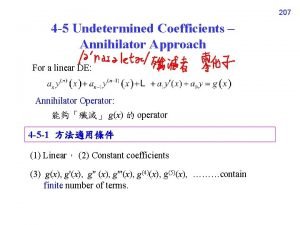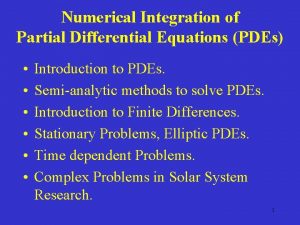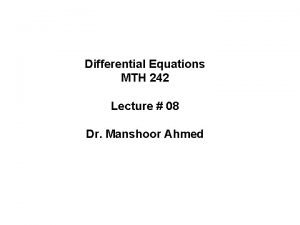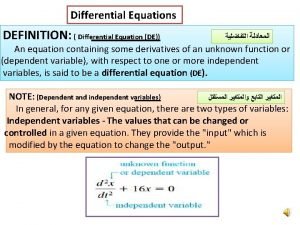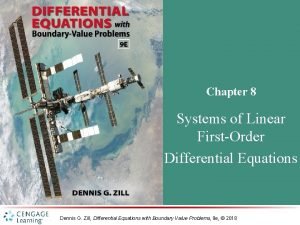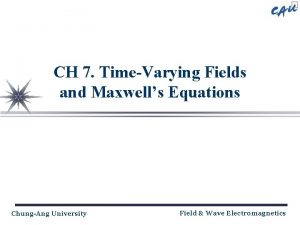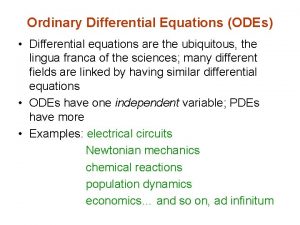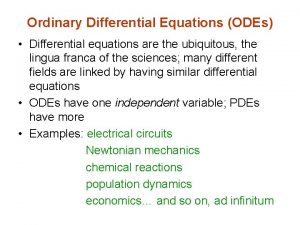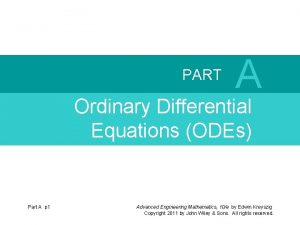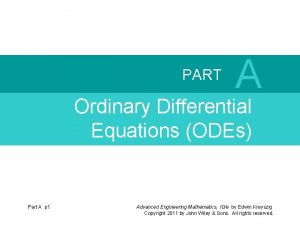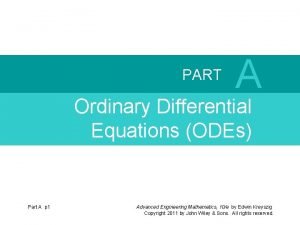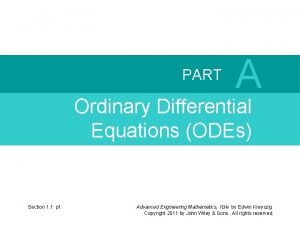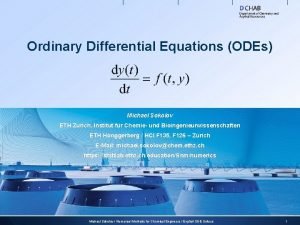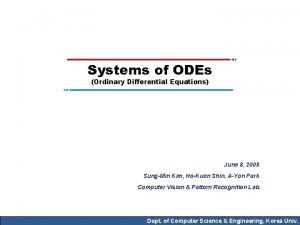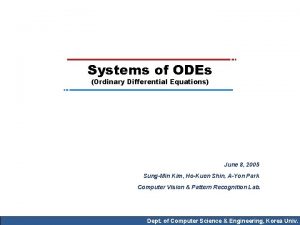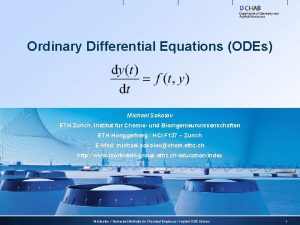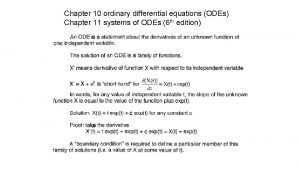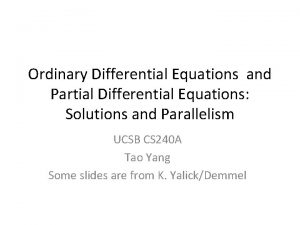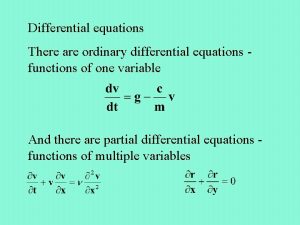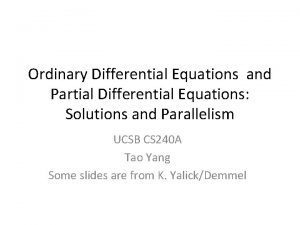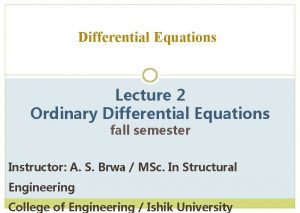PART 7 Ordinary Differential Equations ODEs Ordinary Differential












































![The Laplacian Difference Equations/ Laplace Equation O[D(x)2] O[D(y)2] Laplacian difference equation. Holds for all The Laplacian Difference Equations/ Laplace Equation O[D(x)2] O[D(y)2] Laplacian difference equation. Holds for all](https://slidetodoc.com/presentation_image_h2/cd652c67cadb82a25ef6551a5fe071e6/image-45.jpg)







- Slides: 52

PART 7 Ordinary Differential Equations ODEs

Ordinary Differential Equations Part 7 • Equations which are composed of an unknown function and its derivatives are called differential equations. v - dependent variable t - independent variable • Differential equations play a fundamental role in engineering because many physical phenomena are best formulated mathematically in terms of their rate of change.

Ordinary Differential Equations • When a function involves one dependent variable, the equation is called an ordinary differential equation (ODE). • A partial differential equation (PDE) involves two or more independent variables.

Ordinary Differential Equations Differential equations are also classified as to their order: 1. A first order equation includes a first derivative as its highest derivative. - Linear 1 st order ODE - Non-Linear 1 st order ODE

Ordinary Differential Equations 2. A second order equation includes a second derivative. - Linear 2 nd order ODE - Non-Linear 2 nd order ODE • Higher order equations can be reduced to a system of first order equations, by redefining a variable.

Ordinary Differential Equations

Runge-Kutta Methods This chapter is devoted to solving ODE of the form: • Euler’s Method solution

Runge-Kutta Methods

Euler’s Method: Example Obtain a solution between x = 0 to x = 4 with a step size of 0. 5 for: Initial conditions are: x = 0 to y = 1 Solution:

Euler’s Method: Example • Although the computation captures the general trend solution, the error is considerable. • This error can be reduced by using a smaller step size.

System of Ordinary Differential Equations The solution is finding y 1, y 2, y 3, …yn

Euler’s Method: Example Obtain a solution between x= 0 & 4 (step size of 0. 5) Initial conditions are: x = 0 ; y 1= 4 & y 2 = 6 Solution: X 0 0. 5 1 1. 5 2 y 1 4 3 2. 25 1. 687 1. 265628 y 2 6 6. 9 7. 715 8. 44525 9. 094087

Improvements of Euler’s method • A fundamental source of error in Euler’s method is that the derivative at the beginning of the interval is assumed to apply across the entire interval. • Simple modifications are available: – Heun’s Method – The Midpoint Method – Ralston’s Method

Runge-Kutta Methods • Runge-Kutta methods achieve the accuracy of a Taylor series approach without requiring the calculation of higher derivatives. Increment function (representative slope over the interval)

Runge-Kutta Methods Various types of RK methods can be devised by employing different number of terms in the increment function as specified by n. 1. First order RK method with n=1 is Euler’s method. • 2. Second order RK methods: • Values of a 1, a 2, p 1, and q 11 are evaluated by setting the second order equation to Taylor series expansion to the second order term.

Runge-Kutta Methods • Three equations to evaluate the four unknowns constants are derived: A value is assumed for one of the unknowns to solve for the other three.

Runge-Kutta Methods • We can choose an infinite number of values for a 2, there an infinite number of second-order RK methods. • Every version would yield exactly the same results if the solution to ODE were quadratic, linear, or a constant. • However, they yield different results if the solution is more complicated (typically the case).

Runge-Kutta Methods Three of the most commonly used methods are: • Huen Method with a Single Corrector (a 2=1/2) • The Midpoint Method (a 2= 1) • Raltson’s Method (a 2= 2/3)

Runge-Kutta Methods y • Heun’s Method: Involves the determination of two derivatives for the interval at the initial point and the end point. f(xi, yi) xi f(xi+h, yi+k 1 h) x xi+h y ea Slope: 0. 5(k 1+k 2) xi xi+h x

Heun’s Method - Example Obtain a solution between x=0 & 4 (step size = 0. 5) for: Initial conditions are: x = 0 to y = 1, use Heun’s method Chapter 25

Runge-Kutta Methods y • Midpoint Method: Uses Euler’s method t predict a value of y at the midpoint of the interval: f(xi, yi) xi f(xi+h/2, yi+k 1 h/2) x xi+h/2 y ea Slope: k 2 Chapter 25 xi xi+h x

Midpoint Method (Example 25. 6, P 705) Obtain a solution between x=0 & 4 (step size = 0. 5) for: Initial conditions are: x = 0 to y = 1, use Midpoint method Chapter 25

Runge-Kutta Methods y • Ralston’s Method: f(xi, yi) xi f(xi+ 3/4 h, yi+3/4 k 1 h) xi+3/4 h x y ea Slope: (1/3 k 1+2/3 k 2) Chapter 25 xi xi+h x

Chapter 25 24

Runge-Kutta Methods 3. Third order RK methods Chapter 25

Runge-Kutta Methods 4. Fourth order RK methods Chapter 25

Comparison of Runge-Kutta Methods Use first to fourth order RK methods to solve the equation from x = 0 to x = 4 Initial condition y(0) = 2, exact answer of y(4) = 75. 33896 Chapter 25

Implicit Versus Explicit Euler’s Methods y • Explicit Euler’s Method: h f(xi, yi) x xi xi +h y • Implicit Euler’s Method: f(xi+1, yi+1) f(xi, yi) h x Chapter 27 xi xi +1

The Finite Difference Method • The previous central divided differences are substituted for the derivatives in the original equation. • Thus a differential equation is transformed into a set of simultaneous algebraic equations that can be solved by the methods described earlier. Chapter 27

The Central divided differences f(x) f(xi+1) f(xi-1) f(xi) f(xi) Dx xi-1 Chapter 27 Dx xi+1

The Finite Difference Method-Example Solve the following 2 nd order ODE for initial conditions of T(0) = T 1 and T(L) = T 2 Where Ta and h/ are constants. Solution: • Using the divided differences equations: • Substitute into the original DE for d 2 T/dx 2: Chapter 27

The Finite Difference Method-Example • Now collecting terms gives: • The above equation is now applied at each of the interior point. • The first point and the last point are specified by the boundary conditions. • So if there is 5 points (including the first and the last point) we will have 3 equations in 3 unknowns. Chapter 27

The Finite Difference Method: Example Solve the following 2 nd order ODE for initial conditions of y(0) = 5 and y(10) = -1. 5, Use Dx = 2 • Using the divided differences equations: Chapter 27

The Finite Difference Method: Example • Substitute into the original DE for d 2 y/dx 2 and dy/dx: • Now collecting terms gives and substitute for Dx =2: • The above equations will be used to find the y’s at 2, 4, 6 and 8 where y(0) = 5 and y(10) = -1. 5 Chapter 27

The Finite Difference Method: Example Chapter 27

The Finite Difference Method: Example • Or in a matrix format: • Now you can use for example Gauss elimination to solve these equations. Chapter 27

PART 8 Partial Differential Equations PDEs Finite Difference Method Finite Element Method Chapter 29

Partial Differential Equations Chapter 29

Partial Differential Equations • A partial differential equation (PDE) involves two or more independent variables. For example: 1. Laplace equation 2. Diffusion equation 3. Wave equation Chapter 29

Partial Differential Equations 1. Finite Difference Method • Similar to the ODE, central divided differences are substituted for the partial derivatives in the original equation. • Thus a partial differential equation is transformed into a set of simultaneous algebraic equations that can be solved by the methods described earlier. Chapter 29

Partial Differential Equations The Central divided differences y i, j+1 i-1, j i+1, j i, j-1 Chapter 29 x

Finite Difference: Elliptic Equations • Because of its simplicity and general relevance to most areas of engineering, we will use a heated plate as an example for solving elliptic PDEs. Chapter 29 42

Figure 29. 1 by Lale Yurttas, Texas A&M University Chapter 29 43

Figure 29. 3 by Lale Yurttas, Texas A&M University Chapter 29 44
![The Laplacian Difference Equations Laplace Equation ODx2 ODy2 Laplacian difference equation Holds for all The Laplacian Difference Equations/ Laplace Equation O[D(x)2] O[D(y)2] Laplacian difference equation. Holds for all](https://slidetodoc.com/presentation_image_h2/cd652c67cadb82a25ef6551a5fe071e6/image-45.jpg)
The Laplacian Difference Equations/ Laplace Equation O[D(x)2] O[D(y)2] Laplacian difference equation. Holds for all interior points Chapter 29

Figure 29. 4 Chapter 29 46

• In addition, boundary conditions along the edges must be specified to obtain a unique solution. • The simplest case is where the temperature at the boundary is set at a fixed value, Dirichlet boundary condition. • A balance for node (1, 1) is: • Similar equations can be developed for other interior points to result a set of simultaneous equations. Chapter 29 47

• The result is a set of nine simultaneous equations with nine unknowns: Chapter 29 48

Partial Differential Equations: Example 1: Laplace Equation Laplace: Substitute with the Central divided differences and assuming that Dx = Dy = h

Partial Differential Equations: Example 1: Laplace Equation y At i and j: 1 1 Finite Difference Grid i, j+1 -4 i-1, j i, j 1 1 i, j i+1, j i, j-1 x

Partial Differential Equations: Example 2: Diffusion Equation Diffusion: Substitute with the Central divided differences and assuming that Dx = Dy = h:

Partial Differential Equations: Example 2: Diffusion Equation Diffusion: y At i and j: -1 h/2 a Finite Difference Grid i, j+1 2 i-1, j i, j h/2 a -1 i, j i+1, j i, j-1 x
 Ordinary differential equations ppt
Ordinary differential equations ppt Nonlinear ordinary differential equations
Nonlinear ordinary differential equations Numerical methods for partial differential equations eth
Numerical methods for partial differential equations eth 1st order derivative formula
1st order derivative formula Ordinary differential equations example
Ordinary differential equations example Ordinary differential equations examples
Ordinary differential equations examples Ordinary differential equations
Ordinary differential equations Ode example poem
Ode example poem Cowleyan ode
Cowleyan ode Odės pavyzdžiai
Odės pavyzdžiai Integrating factor of differential equation
Integrating factor of differential equation What is king creon’s reaction to teiresias’ message?
What is king creon’s reaction to teiresias’ message? Poem vs sonnet
Poem vs sonnet Free verse haiku
Free verse haiku John keats 1819 odes
John keats 1819 odes Ordinary points
Ordinary points Differential equations projects
Differential equations projects Pde paula
Pde paula Cengage differential equations
Cengage differential equations Adam moulton method
Adam moulton method Carrying capacity equation calculus
Carrying capacity equation calculus Partial differential equation
Partial differential equation Integrating factor of differential equation
Integrating factor of differential equation First order pde
First order pde First order ode
First order ode Separation of variables differential equations
Separation of variables differential equations Natural solution
Natural solution How to solve second order differential equations
How to solve second order differential equations Pde first order
Pde first order Definition and classification of differential equations
Definition and classification of differential equations Traffic flow differential equations
Traffic flow differential equations Modified euler's method formula
Modified euler's method formula First-order linear equations
First-order linear equations Variable separable
Variable separable Slidetodoc
Slidetodoc Differential equations
Differential equations Differential equations with discontinuous forcing functions
Differential equations with discontinuous forcing functions Bernoulli equation calculus
Bernoulli equation calculus Parachute problem differential equations
Parachute problem differential equations Homogeneous and nonhomogeneous differential equations
Homogeneous and nonhomogeneous differential equations Differential equations and linear algebra strang
Differential equations and linear algebra strang Growth and decay differential equation
Growth and decay differential equation Differential equations zill solutions
Differential equations zill solutions Stewart differential equations
Stewart differential equations Differential equations chapter 1
Differential equations chapter 1 Maxwell's equations differential form
Maxwell's equations differential form Mechanical and electrical vibrations differential equations
Mechanical and electrical vibrations differential equations Annihilator approach
Annihilator approach Integration of partial differential equation
Integration of partial differential equation Higher order linear differential equations
Higher order linear differential equations Differential equations definition
Differential equations definition Mixing problems differential equations
Mixing problems differential equations Derivation of maxwell's equations in differential form
Derivation of maxwell's equations in differential form
